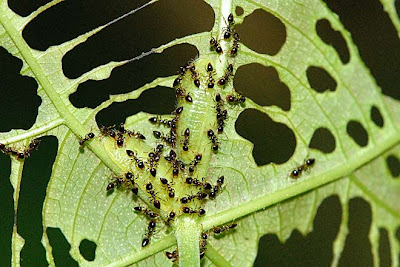17 May was Vesak Day, a gazetted public holiday in a multi-racial and religious Singapore. I was on a casual forest stroll along the Lornie Trail. Not too far from the entrance to the greenery and tranquility of the forest, a Chequered Lancer (Plastingia naga) displayed what a "ghosting effect" whenever I snapped a shot.
 I decided to take some shots from a more difficult angle but with a brighter background - surprisingly, it stayed still. I guess the skipper may be sensitive only to certain intensity of the flash light.
I decided to take some shots from a more difficult angle but with a brighter background - surprisingly, it stayed still. I guess the skipper may be sensitive only to certain intensity of the flash light. 
At the same sunny spot where I shot a bunch of Malay Lacewing (Cethosia hypsea hypsina) larvae here, I saw how arts could be manifested in nature - a cluster of eggs likely to be of Malay Lacewing were lined up on a thin and young stem of a climber.
 This is a male Cruiser (Vidula dejone erotella) whose fulvous-orange colour on both the upper and underside wings are distinctive enough to be seen from far. Though a rather common forest species, we seldom found the female on the ground.
This is a male Cruiser (Vidula dejone erotella) whose fulvous-orange colour on both the upper and underside wings are distinctive enough to be seen from far. Though a rather common forest species, we seldom found the female on the ground.  A commonly seen behaviour of the male is that they like to puddle on damp ground with wings flapping. This was the only timely shot which captured a split-second moment when both wings were almost flat on the ground.
A commonly seen behaviour of the male is that they like to puddle on damp ground with wings flapping. This was the only timely shot which captured a split-second moment when both wings were almost flat on the ground.  This is a female Knight (Lebadea martha parkeri). She liked to glide and perch from leaf to leaf and puddle on the ground occasionally but not for long. Rather alert and skittish, she really tested my patience for getting a decent shot. On the contrary to Cruiser, it seems that the male is less common.
This is a female Knight (Lebadea martha parkeri). She liked to glide and perch from leaf to leaf and puddle on the ground occasionally but not for long. Rather alert and skittish, she really tested my patience for getting a decent shot. On the contrary to Cruiser, it seems that the male is less common. 
Along a shady forest path, this tailed Arhopala hopped across the trail. I identify this as a Tailed Disc Oakblue (Arhopala atosia malayana). Seow TL from ButterflyCircle has also confirmed it.

This is another shot from a different side. Lycaenids in the genus Arhopala would increase the number of butterfly species in Singapore once some lookalikes with very subtle differences are identified with confirmation one day.

The male of the Malay Baron (Euthalia monina monina ) is polymorphic - it has at least 3 different forms here. This is form-monina if I am not wrong.

It also displayed the typical behaviour of puddling on the ground and perching on the leaf surface along the forest trail from time to time.

A small robber fly remained quite still on a leaf.

This is another slightly larger robber fly stretching its hind legs and displaying the same behaviour - looking at the trail.

I aways found robber flies facing the trail, scanning for intruders and ambushing its preys when they perched. I had a "face-off" with this guy.

Association of ants with other insects can be seen quite easily in nature (more info here). Here is a shot illustrating a symbiotic relationship between some small ants and two lycaenid larvae found on a young leaf of a Macaranga plant.

It was a fruitful outing for me - very pleased and relieved to see that the forest is still teeming with life. I will feature some dragonflies in my next post.
excellent photo collection
ReplyDeleteThanks for your kind feedback.
ReplyDelete